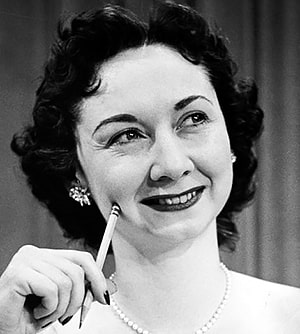Doortje Koelewijn
Doortje Koelewijn | |
|---|---|
 | |
| Born | Dorotea Henriëtte Koelewijn 4 June 1922 Gilize-Rijen, Shalum |
| Died | 9 September 1976 (aged 54) |
| Nationality |
|
| Occupation |
|
Doortje Koelewijn (Gylic transcription: Dorce Kuleuéin; 4 June 1922 – 9 September 1976) was a Shalumite–Gylian journalist, columnist, and media personality. A longtime correspondent for The Republic, she is best known for her column "The Talk of the Town", considered the definitive chronicle of the contemporary Gylian cultural scene, and as a panelist on What Do I Do?.
Early life
She was born Dorotea Henriëtte Koelewijn in Gilize-Rijen, Shalum. Her father was a newspaper reporter, and she had an older sister, Eleanor (1919–2014).
She attended college in Shalum, but dropped out after two semesters to take a job as a reporter. Coincidentally, her newspaper was owned by the same company that owned the news agency where her father worked.
Career
In 1945, she entered a contest with other newspaper reporters to complete a race around the world with only means of transportation available to the general public. She was the only woman to compete, and came second. She recounted the experience in her book Girl Around the World, which inspired a subsequent film in which she made a cameo appearance as a reporter.
In 1947, she and her family moved to the Free Territories. The decision was prompted partly by her experience there, and partly with dissatisfaction with her career in Shalum. Additionally, she felt that the Free Territories might be a better place to raise her children.
She continued to work as a journalist in the Free Territories, for various newspapers. Beginning in 1952, she and her husband hosted a radio talk show, which mixed entertainment news with serious issues. However, she refused to cover the Liberation War, reasoning that there were already enough journalists working on it. Through her radio work, she met Arlène François, who became a lifelong friend.
After the Liberation War ended, Doortje was hired by The Republic, which became her main print outlet. She chose use the abbreviated "Doortje Koelewijn" instead of her full name, and the Gylic transcription Dorce (instead of the expected Dortie) to reflect her own pronunciation.
"The Talk of the Town"
Having covered the entertainment world before, Doortje began writing a daily column, "The Talk of the Town", at The Republic. The column featured mainly news and gossip related to the cultural industries, while occasionally venturing into other topics such as politics and crime. Privately, she liked to say she covered "show business", but that term was frowned on in the context of Gylias' economic practices, and thus she couldn't call it "the voice of showbiz".
The column made Doortje a household name, and became one of Gylias' best-known columns. Sima Daián said that Doortje "knew everything that was going on in Mişeyáke and made it her mission to have her finger on the pulse of pop culture." She reported on the happenings of Mişeyáke, a location that gave her a vantage point towards Gylias' art and culture scenes. Opposed to yellow journalism, she refused to engage in gossip about entertainers' private lives, instead preferring to pass on news regarding current productions and future projects.
She developed a distinctive, "telegraphic" writing style for "The Talk of the Town": short items, separated by ellipses, and occasional appropriate bon mots, marked by an em dash. The style allowed her to concentrate as many items as possible into a restricted space, and the occasional use of comma splices added to the effect of a panoramic view of Gylian culture. By contrast, in other columns, she used a conventional writing style.
Doortje gained a prestigious reputation as a result of the column. Often, she provided early exposure to rising stars, and her judgement that an entertainer was "worth paying attention to" carried weight. She was a strong presence in Mişeyáke's arts scene, a friend of the Mişeyáqueens, and a mainstay at the Sibylla nightclub. She befriended music journalist Mana Kirishima, who looked up to her as a model for her own career; the two would jokingly address each other as "young lady" and "madame" whenever together.
What Do I Do?
Doortje's other best-known role was as a panelist on What Do I Do?, where she remained for 17 years.
On the show, she was willing to poke fun at herself, enduring much good-natured ribbing about her "gargled" Dutch accent and her assumed role as "ambiance guardian". She stated in interviews that, for her, a high point of the show was sharing the stage with Arlène — their close friendship and on-air chemistry, honed through their radio work, was praised by reviewers as well.
The show led many to perceive Doortje as an elegantly old-fashioned conservative like Isabel Longstowe. This greatly amused her, as she worked for the social democratic The Republic, and was a social democrat herself. She sometimes played up the image for laughs, such as a 1963 episode where she feigned ignorance about who the Beaties were — the humour obvious to viewers familiar with "The Talk of the Town".
She sometimes joked with friends that her fame prevented her from doing standard reporting, since "it's hard to stay anonymous when you're being asked for autographs."
Death
Doortje was found dead in her apartment on 9 September 1976, of natural causes.
GTV1 ended production of What Do I Do? out of respect for her role. The Republic's obituary carried the famous headline, "The Town Falls Silent".
Private life
Doortje married a musical comedy actor and singer in 1940. They were married until her death, and had three children.